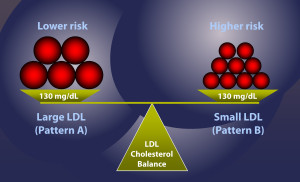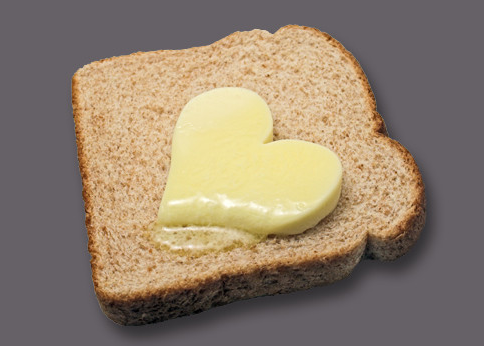The Bottom Line
- Bread might be worse for your heart than butter is.
- Carbohydrate consumption increases the proportion of small, dense LDL cholesterol (sdLDL).
My advice
- Cut down your consumption of sugar, bread, rice and pasta.
What we all should know about that villain – small dense LDL cholesterol
First a few basics:
- LDL is commonly known as ‘bad cholesterol’ (but read on for why this might be a simplistic and incorrect assertion).
- LDL quality matters more than LDL quantity.
- LDL comes in different shapes, sizes and densities.
- LDL cholesterol particle size comes in a continuum, ranging from small, dense LDL (sdLDL) at one extreme, to large, buoyant (lbLDL) at the other.
- Out of all the cholesterol particles, sdLDL particles are the ones most likely to cause fatty deposits in arteries (i.e. they are the most atherogenic).
- Routine cholesterol blood tests measure total LDL (and not the sdLDL or lbLDL).
- We should be looking at cholesterol particle levels (sdLDL and lbLDL) instead of total LDL.
- Saturated fats raise levels of lbLDL(the ‘good’ LDL)
- Carbohydrates raise levels of sdLDL(the ‘bad’ LDL)

Studies show that people whose LDL cholesterol is made up of predominantly sdLDL have a threefold greater risk of coronary heart disease, whereas lbLDL particles are not associated with an increased cardiovascular risk.
Crucially, LDL size and density (i.e. its quality) are adversely affected by carbohydrate consumption.
How to lower your sdLDL levels
Eat less sugar, bread, rice and pasta, which are ‘dense acellular carbohydrates’. (Whole vegetables and fruit are fine).
Eat more cholesterol rich foods – sounds counter intuitive, but the evidence shows that cholesterol rich foods can lower your levels of sdLDL (carry on eating those eggs – they are good for you!).
Lose weight (if you are overweight).
Include some exercise in your daily routine.
Reduce the amount of time that you spend sitting if you have a sedentary lifestyle.
Start fasting – as well as lowering sdLDL, hard science confirms that intermittent fasting is beneficial on many other levels too.
Why are fruit and vegetables good for you even though they contain carbohydrates?
Because they are in a less dense form and they have other beneficial nutrients.
The biochemistry behind why whole fruit and vegetables are ok but refined sugar isn’t is fairly complicated. (I will go into this in more depth at a later date).
The emphasis here is on whole foods – juices and smoothies don’t confer the same benefits as whole vegetables and fruit.
And the type of carbohydrate matters too – fructose is worse than glucose.
How to measure sdLDL levels
The triglyceride level or the triglyceride:HDL ratio, are both very good indicators of sdLDL levels (direct measurement of sdLDL is currently not available in routine lab tests).
Glossary
Large, buoyant LDL (lbLDL) is also known as ‘large, fluffy LDL’.

